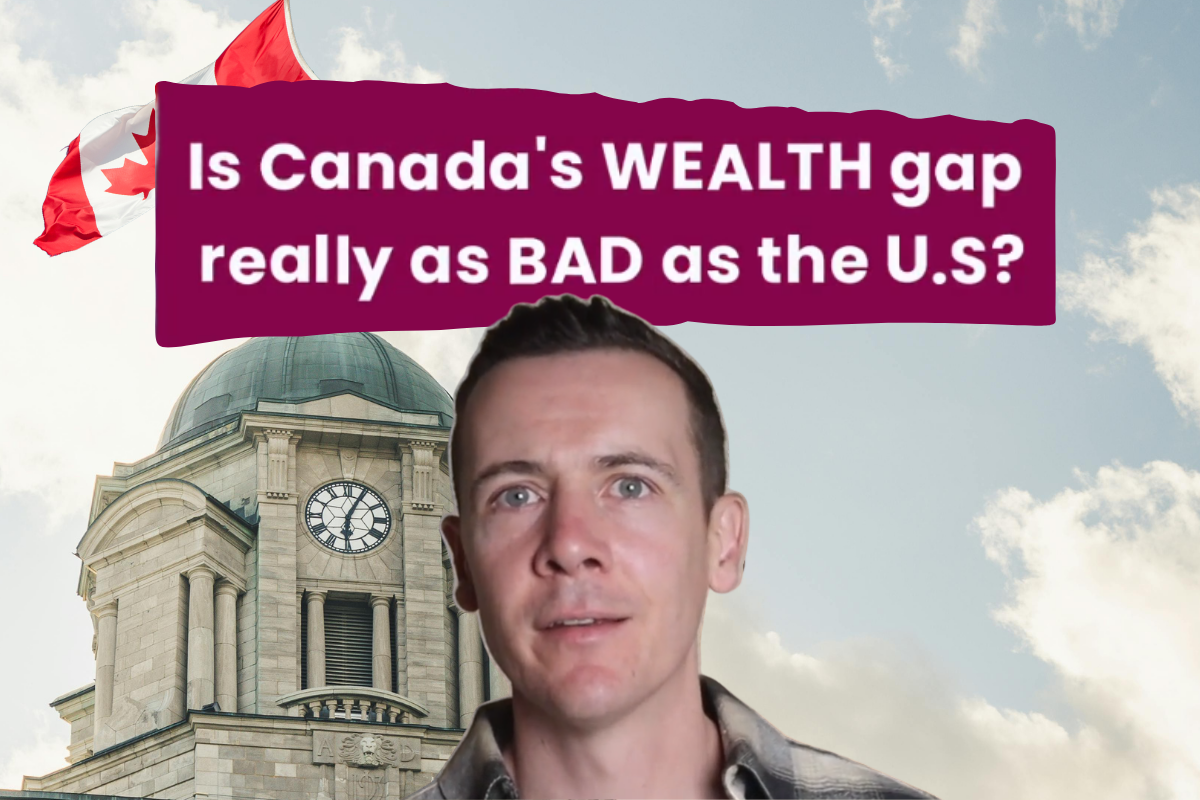Pipelines and algorithms aren’t going to save us | The Hill Times
By Matthew Mendelsohn | This post first appeared in The Hill Times
If you came down from Mars and followed Canadian news this past year, you would think our economic well-being was contingent on natural resources, energy, and infrastructure development. And that, in the future, we will need to complement that foundation with a focus on tech, innovation, and artificial intelligence.
This strategy misses too much, and will leave Canadians more vulnerable to the Trump administration’s ongoing threats to inflict pain on Canadians and our economy.
Obviously, successfully executing on private- and public-sector investment strategies on big natural resource and infrastructure projects, and deploying AI in ways that don’t threaten democracy or exacerbate inequality, will be crucial to Canada’s long-term prosperity.
But if you walk into almost any community across the country, the economic hum isn’t coming from a mine or an AI lab. It comes from the cafés, dental offices, repair shops, health-care practitioners, educators, small manufacturers, and coaches of all kinds. Local businesses and non-profits sustain daily life and economic well-being. They are important sources of economic activity. But, thus far, the federal government’s economic priorities have not focused on these activities.
It is not surprising.
The extraction, export, and processing of natural resources have been important to Canada’s economy for hundreds of years. Our export-oriented resource sector and primary industries will remain important to our future, and powerful corporate interests have loudly expressed their dissatisfaction with federal policy on climate and development over the past decade.

And Canadian tech entrepreneurs—also influential with the federal government—are right that Canada has not been strategic about tech-led economic growth and that we’ve allowed our intellectual property to be sold off. Canada does have many advantages in AI that we should exploit in order to build great tech companies.
But these two priorities are clearly not going to be enough. Really smart investment strategies on natural resources and AI alone will not get us through this moment of geopolitical rupture.
Most Canadian jobs are not directly impacted by tariffs and most of our businesses aren’t export-oriented. Small and medium-sized enterprises (SMEs) contribute just over half of Canada’s GDP and employ 64 per cent of our people. Smaller businesses, locally owned enterprises, not-for-profits, and social enterprises employ and reinvest locally, act as important local economic infrastructure and provide services that are crucial for well-being. They are automatic stabilizers in the face of tariff threats that are outside our control.
Yes, there is a need to mobilize large pools of capital to invest more in big national projects and in new sectors. But there are also capital and investment gaps for smaller, locally owned businesses and not-for-profits.
Canada’s banking regulator, the Office of the Superintendent of Financial Institutions (OFSI), has begun to highlight some of these financing gaps. According to OSFI, Canadian banks are in a position to extend nearly $1-trillion in additional loans to SMEs while staying above their capital minimums. This financing is not reaching many small- to medium-sized enterprises that need it, in part because OSFI’s existing risk-weighting rules make those loans less attractive.
The Competition Bureau has also recently launched a consultation on the state of financing of SMEs, with a particular focus on access to loans, highlighting the growing concern that smaller businesses do not have access to affordable financing and that our existing commercial banks may be part of the problem. Social enterprises, not-for-profits, and co-ops have long highlighted that their financing needs are overlooked by mainstream institutions.
Pension funds and philanthropic foundations have also been called out for failing to invest sufficient Canadian capital into local communities. With trillions of dollars of assets under management, the Department of Finance suggests that even a small reallocation towards domestic investment would produce enormous net-new economic activity in Canadian communities, with little new risk.
And perhaps, most importantly, regardless of what the banks and pension funds do, the federal government needs to step up to support community and social finance infrastructure.
Canada’s social finance leaders have already highlighted the kinds of activities that could be funded. They include recapitalizing the Social Finance Fund, creating loan guarantee facilities for local enterprises and not-for-profits, and making it easier for employees, new entrepreneurs, and communities to purchase businesses from retiring owners and keep them local.
These choices do not require the federal government to spend new funds. They require policy change and, in some instances, more creative uses of the federal balance sheet to finance local economic activities.
The federal government is undertaking some steps to align with this vision: the $10-billion in loan guarantees to Indigenous communities to enable equity in natural resource and other major projects, and the partnership between First Nations Bank and the Business Development Bank of Canada to facilitate the acquisition of existing businesses by Indigenous communities are two recent examples. But the federal government must do more to make low-cost capital available.
As the federal government focuses on big, new projects and sectors that are attracting huge pools of global investment, we have to also address the financing needs of local businesses and not-for-profits. We can build a more resilient economy by also investing in the sectors that dominate people’s daily lives.
What's wrong with mainstream economics?
By Guillaume Vallet and SCP Fellow Louis-Philippe Rochon
In science, when an idea or theory is proven wrong, it is rejected by the profession at large and cast aside in favour of the new idea, which then establishes itself and gains prominence.
Before that happens, tests are done to ensure its validity. Science is self-correcting, which challenges scientists to rethink assumptions, develop new experiments and construct more accurate models. When a theory is proven wrong, it’s not a failure as much as a sign of progress in understanding the world and the environment in which we live.
History is full of examples of evolving ideas. For instance, upon proving that it is the earth that rotates around the sun, the geocentric theory of the universe was abandoned in favour of the heliocentric model.
But, for some reason, this scientific methodology does not seem to apply to economics.
Indeed, the mainstream view – or what we call neoclassical economics – still stands today, despite some or all of it having been shown to be empirically wrong on countless occasions.
The persistence of traditional economic thinking can be attributed to a combination of institutional inertia, ideological alignment, financial incentives and methodological appeal. Neoclassical economics has long been the foundation of most university economics programs, textbooks and professional journals, and graduates of these programs find well-paying jobs in consulting and investment banking.

The old paradigm
Generations of economists have been trained within this paradigm, which assumes that consumers make rational decisions, that businesses aim to maximize profits, that people act independently based on all the relevant information and that markets will self-regulate in response to supply and demand. Departments, funding structures and professional incentives such as university promotion and academic tenure reward adherence to these established ideas and models, making it risky for scholars to challenge the orthodoxy.
Neoclassical economics also aligns well with some dominant political, ideological and financial interests—especially those favouring free markets and limited government intervention. Traditional, “mainstream” economics often calls for policies like deregulation, tax cuts and privatization, which are attractive to powerful economic actors, which has helped maintain its influence in policy-making circles.
There have been many empirical studies that undermine or invalidate key arguments of this old paradigm.
Yet, the economics profession at large has simply ignored these studies and carried on as if nothing happened.
One of the most helpful examples to look at is the 2008 financial crisis.
Between 2008 and 2011, professional economics conferences were dominated by papers analyzing what had happened. Then, after that, the topic fell off the table, and my colleagues carried on as if nothing had happened. Indeed, they refused to blame their flawed economic theory – let alone policies they had recommended – for the crisis.
Many of us who are critical of mainstream economics saw something different. We argued that the crisis wasn’t just a “bad shock,” but the result of how the financial system was designed. Starting in the 1980s, banks and investment firms were deregulated, letting them invent risky products, like mortgage-backed securities, and chase profits through speculation rather than productive investment. Some of us saw this downturn as predictable.
But, then-governor of the Federal Reserve Bank, Ben Bernanke pronounced that “although economists have much to learn from this crisis… calls for a radical reworking of the field go too far.” Such statements prompted many to ask whether economics is even a science. However, because too many interests were tied to the status quo, most seemed to conclude that “the theory is fine.”
But the theory is not fine: prevailing economic theory does not represent the world in which we live. And bad economic theory leads to bad economic policies. As economist John Maynard Keynes said, if we rely blindly on traditional economic theory, it can be “misleading and dangerous.” This is truer today.
Assumptions that simplify the complexity of human behaviour into predictable patterns do make it possible to model economic activity mathematically. But, as Nobel Laureate Paul Krugman said, neoclassical economists “mistook beauty, clad in impressive-looking mathematics, for truth.”
While traditional economic assumptions allow for elegant models and clear predictions, they overlook the sometimes irrational, messy, real-world complexities in which we live.
It is important to expose some of the most important myths in economics, as this carries important consequences for economic policy and, of course, economic growth.
Myth 1: Inflation is the result of excess demand and, as such, is often the result of government deficits or overspending.
In reality, inflation is determined by the costs of production and has very little to do with excess demand. As the post-pandemic surge in inflation has shown, the price of oil and other commodities, costs of transporting goods and bottlenecks all contribute to rising inflation.
Myth 2: Central banks are uniquely positioned to fight inflation, and higher interest rates are needed to fight inflation.
This myth stems from the first idea. But if inflation is not caused by demand, policies designed to deflate the economy and hence demand are ineffective in fighting inflation. Higher interest rates may not be the best solution and may actually cause more harm.
Myth 3: Growth is good for everyone, as it raises all ships.
This applies both domestically and globally. Indeed, if there is one thing we realized from globalization it’s that it actually benefited the very few, while the rest suffered.
Myth 4: Central banks need to be independent in order to fight inflation.
First, as stated above, inflation is cost-related and, hence, monetary policy does little to affect it. Second, central banks work very closely with governments and banks to ensure financial stability. The Bank of Canada works closely with federal and provincial financial authorities, the Office of the Superintendent of Financial Institutions (OSFI) and the Canada Deposit and Insurance Corporation (CDIC). They may be independent of political pressure to change interest rates, but they are sensitive to the needs of banks and financial interests.
Myth 5: Income inequality is determined by markets.
In reality, inequality is not inherent, but a product of power dynamics in capitalist systems. Markets are governed by a few powerful firms, and this concentration allows firms to charge higher prices and increase their profits, thereby lowering the share of wages in the economy. Those making decisions can choose to inflate executive compensation and returns to shareholders rather than labour. Inequality is a choice and not a market-determined one.
–
The economy is going through unbelievable structural transformations, and the nature of capitalism is being remade. Clinging to disproven theories because it is convenient will result in economists who cannot help explain what is going on, nor advise what to do about it.
Better economic theory recognizes things like income inequality and discrimination are some of the biggest economic and political problems today, and that conventional economics is too heavily influenced by those who own and control wealth and power.
Our misfortune, to paraphrase John Kenneth Galbraith, is that these mainstream economic theories and policies have been tried and failed miserably. Yet, we always insist on repeating our failed experiments. If that is not irrational behaviour, we don’t know what is.
Building a thriving economy: CSA Policy Pathways Conference
The CSA Policy Pathways Conference: Building a Thriving Canadian Economy
Panel discussion: Centering equity in economic policy
Wednesday, Nov. 5, 2025
11:30 am – 12:30 pm
The Quay – Toronto Region Board of Trade
100 Queens Quay East
Toronto, Ontario
Panelists
Béatrice Alain
Executive Director, Chantier de l’économie sociale
Narinder Dahmi
President, The Sonor Foundation and Co-founder, New Power Labs
Jennifer Robson
Associate Professor, Director of the Graduate Program in Political Management at Carleton University
Moderator
Matthew Mendelsohn
CEO, Social Capital Partners
Creativity could be collateral damage of U.S. film tariff
By SCP Fellow Biju Pappachan | This post first appeared in Playback
When I read that the U.S. plans to impose a 100% tariff on foreign-made films, I didn’t think about Hollywood first. I thought about the crews, editors and emerging filmmakers here in Toronto. The people who make a living behind the camera and the underrepresented young creative workers we train every day at POV — a workforce development charity dedicated to training diverse talent.
This latest announcement from President Trump’s administration is a reminder that the cultural industries, including film, television, gaming and advertising, are not immune to politics. They are part of global trade. And when cultural trade becomes a weapon, creativity becomes collateral damage.
Canada’s screen economy is a jobs engine, contributing approximately 239,000 jobs and $14.05 billion to our GDP annually. Undermine that, and you undercut one of our most globally competitive sectors.
For decades, Canada has been one of the world’s busiest production hubs. Our country welcomes major U.S. shoots and hosts world-class crews. Every year, young Canadians, many from underrepresented communities, step onto a set for the first time, see their names in credits and start to build film and television careers.
A 100% film tariff could undo all the investments and efforts that have built this momentum, and here’s why. Canadian productions often rely on U.S. partnerships for financing, equipment and distribution. Tariffs that double the cost of foreign content entering the U.S. would make those deals much harder to secure. Coproductions would stall and costs for imported gear and set materials would get higher. Independent films would never cross the border.

Due to this uncertainty, productions would inevitably slow and the first people to lose work would be the crew, trainees and new graduates — the very creatives POV strives to help break into the industry.
Even in the U.S., critics are calling the proposed move misguided. Actor George Clooney said it best, that if “[Trump] wants to fix [the industry], then he should talk about a federal incentive.”
Short-term implications
The threat alone could have dire consequences and has already started to stress the Canadian creative industries, injecting uncertainty into planning, financing and production and shaking investor confidence.
For the average Canadian, the effects of film tariffs might feel abstract. But for the young creative workers we train at POV, tariffs are a very real threat. If production slows, it’s these new creative workers who will lose out on internships, apprenticeships and the first jobs that turn their training into careers.
At a recent in-person gathering at POV, where new creatives and independent filmmakers swap stories, the anxiety was clear. As one filmmaker put it, “tariffs could leave small productions stranded and crews without work … budgets are already thin and the extra costs risk making projects unviable.”
In the abstract, it might feel like film tariffs would squeeze corporations, but the reality is that they would squeeze ground-level crews and filmmakers across the industry. Not only do our screen industries generate export revenue and create domestic jobs, they showcase Canadian stories on the global stage. Weakening this sector would undermine both our economic and our cultural sovereignty.
Next steps
Canada’s politicians, policymakers and funders at all levels need to double down on support for this multibillion-dollar industry.
At the federal level, Ottawa should move quickly to secure tariff exemptions for essential screen industry goods such as gear, equipment and set construction. We need to oppose U.S. film tariffs that would tax imported films, TV shows or digital media as “intangible” content. Our trade diplomats should be in Washington now, making the case that tariffs would damage both sides of the border.
The U.S. film and television industry relies heavily on Canadian production services; everything from Toronto sound stages and visual-effects houses to post-production teams in Montreal and Vancouver. In 2023-24, 86% of all foreign film and TV projects shot in Canada originated from the U.S., supporting thousands of American-backed jobs here and reducing costs for those companies. Disrupting that network would raise expenses for U.S. producers and slow their release schedules, hurting American just as much as it would hurt Canadian crews.
At the provincial level, we can protect our global competitiveness by adjusting tax credits to neutralize tariff-induced production costs, fund training and subsidize paid job placements that sustain the entire screen production ecosystem, including grips, lighting and post- production, so entry-level and diverse talent aren’t casualties.
And at the municipal level, cities like Toronto need to keep doing what they do best: removing barriers, streamlining permits and supporting local suppliers.
Time to stand up
Some argue that U.S. tariffs could push Canada to rely more on its own domestic productions, and there’s some truth to that. A moment like this could inspire new investment in Canadian stories and storytellers, giving local producers a chance to fill the gap if U.S. work slows. But the domestic market alone can’t sustain the full scale of Canada’s creative workforce. Our industry is built on collaboration, coproductions and international distribution. What we make here often finds its audience abroad, especially in the U.S., our largest trading and cultural partner.
That’s why tariffs could be so dangerous. They don’t just threaten investments and budgets; they threaten the reach of our stories. The creative economy is one of Canada’s greatest exports because it carries our values, diversity and identity to the world. Tariffs on films aren’t just about money — they are about who gets to tell their story and whether that story is allowed to cross borders.
When tariffs threaten to strike creativity and culture, we can’t afford to stay quiet. This is the moment for Canada to stand up for its filmmakers, crews and cultural sovereignty. Film and television are not luxuries; cultural production is a strategic sector that delivers exports, jobs and soft power. Just as we negotiate for agricultural or industrial tariff exemptions, cultural production deserves equal protection.
By investing in our film and television industry, safeguarding cross-border partnerships and making sure young, diverse talent continues to find opportunity here at home, we can protect and strengthen the voices of the next generation of Canadian storytellers.
Biju Pappachan is executive director of the charity POV, where he leverages his extensive experience in driving systemic change to advance the organization’s mission of promoting economic inclusion. He has developed and launched innovative workforce development strategies that support BIPOC and diverse young creatives. He is currently a research fellow at policy non-profit Social Capital Partners.
Hype or help? Can crypto and stablecoins solve economic inequality?
By SCP Fellow Dan Rohde
Cryptocurrencies, like Bitcoin, are caught between two worlds. On the one hand, they fancy themselves “currencies” – promising to be an effective means of payment. On the other hand, cryptocurrencies act as speculative assets – things purchased today with the hope that they will increase in value down the line.
The problem is that these two functions often conflict with one another. And while crypto assets have proven effective speculative assets (indeed, they’ve made some speculators quite a lot of money!), they’ve proven quite bad as a means of payment. Exchanges, and stablecoins, are the primary means by which crypto advocates are attempting to bridge this gap – to move from the world of speculation to a functional means of payment. Sadly, the result leaves much to be desired, and, in my opinion, adds rather little to our existing payment infrastructure.
This hasn’t stopped advocates, like Mike Moffat, from promoting the use of stablecoins as a common currency. His argument is that this new currency could help the cost-of-living crisis and promote economic equality – particularly for young people. I am not convinced that crypto can help address economic inequality. Before we get into that, let’s break down what stablecoins are and aren’t, and how to think critically about their promises.
To be effective, a currency should have at least two things. First, it should be an easy mode of payment. If it’s a pain to use something to buy and sell things, you’ll typically use something else. (For example, the easier debit and credit cards have become to use, the more they displaced cash as a mode of payment.)
Second, it should have a relatively stable nominal value. It’s vitally important to know, when you go purchase a coffee, that the toonie in your pocket will actually buy you that $2 coffee without haggling or negotiation. In other words, the number on your money should generally be what it’s worth in purchases. The more variation you have, the harder it is to use your money as a means of payment.

Cryptocurrencies are generally very bad at both of these: here’s how. Bitcoin, just to take a well-known example, distinguishes itself by saying that it’s a fully anonymous means of peer-to-peer payment that does not require financial intermediaries, like banks or credit card companies. It casts itself as “digital cash” that you can exchange directly with your peers. To accomplish this, it uses elliptic-curve cryptography to anonymously process payments between digital wallets – a process that requires so-called “miners” to expend considerable energy and computing power to validate each transfer. While estimates vary, one study suggested a single bitcoin transfer can require between 100 and 1000 kWh, compared to .001kWh for a credit card purchase. (This means that a single bitcoin purchase can take around 500,000x more energy than a credit card purchase!)
The time involved in processing a crypto payment is also substantial: Bitcoin payments can get confirmed in about 10 minutes, but typically take 1-1.5 hours to complete. Imagine waiting 10 minutes to confirm payment of your coffee. For this reason, bitcoin transactions very often occur over a crypto-exchange. (Imagine a stock exchange, but for crypto assets.) This greatly simplifies the process of moving assets between holders, but it also does away entirely with that idea of bitcoin being anonymous and independent of financial intermediaries.
Cryptocurrencies are also notoriously bad at holding a stable nominal value. Like all speculative assets, their value rises and falls continuously based on available prices on the market. At any given moment, you don’t know exactly how many $2 coffees your bitcoin will buy you. At the time I am writing this, one Bitcoin, or “Btc,” is valued at about $114,000; exactly 4 hours ago, it was just over $112,000; six months ago, it was $75,000. This kind of variability is fine when you’re playing the markets, but it’s terrible for making everyday payments.
Stablecoins were developed to overcome these problems. A stablecoin is a type of crypto asset that, unlike Btc, isn’t anonymous, peer-to-peer or even necessarily protected with any sort of cryptography. Rather, a stablecoin is issued by a private company, and pegged to a regular fiat currency (like the U.S. dollar, or USD). What does it mean that the coin is “pegged” to a regular fiat money? All it means is that the issuer promises their coins can be redeemed at any time for their face value in regular money. So, one USD-pegged coin can be redeemed for $1 in your bank account. Stablecoin issuers maintain this peg by holding a set of liquid financial assets that they can sell off at any time to ensure they have enough money to pay out redemptions. Placing stablecoins on an exchange where they can be easily swapped with crypto assets like bitcoin aids in converting crypto-assets into regular money and helps anchor their nominal value.
If this stablecoin setup sounds vaguely familiar to you, that’s because it is: it’s exactly how your bank works! Your bank issues credits denominated in Canadian dollars, or CAD. They don’t call those credits “coins,” but that doesn’t matter very much. Your bank ensures that the credits they offer (which we call “deposit accounts”) stay pegged to CAD by holding a large, diversified set of liquid financial assets, by subscribing for deposit insurance under the Canadian Deposit Insurance Corporation, or CDIC, and playing a part in Canada’s financial safety net.
However, there is one big difference between your bank and a stablecoin issuer: your bank is tightly regulated under the Office of the Superintendent of Financial Institutions (OSFI) and the Financial Consumer Agency of Canada (FCAC) and can turn to the Bank of Canada in a crisis. In contrast, your local stablecoin issuer is likely trying its best to avoid any and all such regulation as far as it is able. You can hope they are being honest about their assets, but all you really have is hope.
Like many pieces about crypto and stablecoins recently, Moffat’s blog points to many, very real problems with our current financial system. He points out how expensive credit card transactions are for small businesses, and how difficult it can be to transfer money abroad. (Here, for example, is an excellent recent article about credit-card fees.) These are very real problems, ones that particularly affect small business, and that call for real solutions. He also points to a very genuine and important ambiguity as to how stablecoins should be regulated – either under the Federal Government’s power to regulate ‘banks’ or under the provincial power to regulate ‘securities.’
The big question, however, is what crypto actually does to solve these problems.
Moffat says that stablecoins can be programmed/designed to provide cheaper payments and higher rates of interest for young and middle-income savers. He doesn’t specify anywhere exactly how or why they don’t already do this. What type of “programming” is going to make lending to younger or lower-income individuals profitable for stablecoin issuers or crypto lenders when it isn’t for banks? How is it that stablecoin issuers, which adopt much of the model of regulated banks, could offer more “frictionless” payments than the existing payment system? How exactly are stablecoins, which are tied to notoriously volatile crypto markets, going to help younger individuals save safely for a home?
Advocates often wax lyrical on crypto’s potential to usher in economic equality, and they often build their case on very real problems with our financial and payments system. But we should not so easily buy into their myths. While I’m not making any claims about Moffat in particular, advocates are very often (though not always) out to hype their product rather than advocating for real solutions to these problems. We should always ask whether what they are offering actually adds anything of value to be considered.
There are no doubt real problems with our current banking system that contribute to economic exclusion and inequality. As Moffat points out, fees for international remittances are large. Too many Canadians are “underbanked,” denying them access to vital payments and lending infrastructure. Rather than turning to crypto, which was founded on libertarian anti-government ideology, there are other potential solutions to these problems.
Canada could directly regulate credit card fees or international remittances to help consumers, small businesses and people sending money to family abroad. Open banking also provides an avenue to rethink public access to credit. Lastly, but perhaps most importantly, we could (and should) consider developing a public digital currency, such as a Central Bank Digital Currency (CBDC). Why shouldn’t the state, which already provides cash free of charge, provide a public, digital money? A type of debit card that small businesses can accept without paying fees to banks. Wouldn’t that address many of the main issues with our current system without turning to digital libertarians?
At best, stablecoins mimic what our banks already do, only with less transparency and oversight. If we want a payment system that is cheaper, fairer and more inclusive, we should look through the hype to real policy innovations to deliver genuine improvements for Canadian households and businesses.
Budget 2025 should bolster employee ownership to strengthen Canada’s economy | Canadian Dimension
By Simon Pek, Lorin Busaan and Alex Hemingway | This post first appeared in Canadian Dimension
In his first post-election news conference, Prime Minister Mark Carney made a bold commitment to “take control of our economic destiny to create a new Canadian economy.” If that is to happen, Canadian employees deserve more than inspiration—they deserve a greater ownership stake and voice in the companies where they work.

In Budget 2023, the federal government enabled the creation of employee ownership trusts (EOTs), which can purchase and hold shares of businesses in perpetuity on behalf of employees. Unfortunately, the associated capital gains tax incentive was limited to three years and will expire in 2026. Budget 2025, expected this fall, is an opportune moment to make employee ownership permanent by extending and expanding the capital gains exemption for EOTs.
Employee ownership trusts are one model among several of broad-based employee ownership, and empirical research from around the world shows they have strong benefits for firms, employees, and the broader economy: greater resilience, improved productivity, reduced inequality, and stronger continuity in business succession. For example, a recent UK study found that companies converting to employee ownership via EOTs have, on average, enjoyed a 4.4 percent higher productivity increase over three years compared to similar firms.
Early conversions in Canada—at companies like Taproot Community Support Services, Brightspot Climate, and Grantbook—suggest strong interest among both business owners and employees in this model. Based on the highly successful UK experience, it is plausible that hundreds—if not thousands—of conversions could eventually take place here. In the UK, much of the uptake has been driven by deliberate policy decisions: generous tax relief, clear regulatory definitions, and awareness-raising among business owners.
Canada’s federal government has made a promising start with the temporary capital gains exemption—but with limits. The exemption on the first $10 million of capital gains for business sales to EOTs is important. Yet many EOT transactions take more than a year to plan and complete. If the incentive expires prematurely in 2026, many potential transitions may be abandoned or indefinitely deferred.
To avoid losing momentum, Ottawa should extend the capital gains exemption indefinitely rather than letting it lapse after only two years. A permanent exemption would give business owners certainty and allow longer planning horizons, encouraging thoughtful, sustainable conversions instead of rushed ones. Just as importantly, the exemption should be broadened to include worker cooperatives. Budget 2024 proposed such an extension to eligible worker cooperative corporations, but that legislation was never finalized. Worker co-ops are a long-standing model of employee ownership in Canada, offering employees direct control rights and a tradition of democratic governance that complements the EOT framework.
The cost to the federal government is modest. The Office of the Parliamentary Budget Officer has estimated foregone tax revenues from the temporary EOT exemption at approximately $7 million per year. Compared with other tax exemptions—such as the principal residence exemption, which costs the federal and provincial governments billions annually—this is minimal. Even if extended to include worker co-ops, the revenue impact would remain limited relative to the economic and social benefits generated.
Those benefits are substantial. Firms that convert to employee ownership tend to be more resilient in economic downturns, with lower incidence of layoffs and closures. Evidence from the UK shows employee-owned businesses are far less likely—by a factor of five—to lay off their staff over a three-year span than comparable firms. Employee ownership also supports stable employment in smaller communities, strengthening Canada’s economic sovereignty by keeping ownership and decision-making local.
Workers gain too—not just through job security but through income and wealth accumulation, particularly for groups facing economic exclusion. US studies show that employee ownership reduces wealth gaps, boosts household incomes, and gives workers a direct stake in profits. The social dividends extend beyond pay: employee-owners often report higher morale, greater civic engagement (including higher voting and volunteering rates), and stronger commitments to environmental practices within their firms.
Canada is at a pivotal moment. More than $2 trillion in business assets are projected to change hands in the next decade. This demographic shift, with retiring business owners seeking succession paths, creates a rare opportunity to shift large swathes of private enterprise toward employee ownership. If Budget 2025 extends and expands the capital gains exemption, this would be a powerful lever: enabling business succession that preserves jobs, strengthens communities, and shares wealth more broadly. Such a policy would likely enjoy support across the political spectrum and from the business community, and could be a quick win for Canada’s economic sovereignty.
Simon Pek is an associate professor in the University of Victoria’s Gustavson School of Business.
Lorin Busaan is a PhD candidate at the University of Victoria’s Gustavson School of Business.
Alex Hemingway is a senior economist at BC Policy Solutions.
What being an employee-owned company means to me
By Social Capital Partners
On a personal level, when you “take ownership” over something, it means that you take responsibility for your actions, ensure tasks are completed and goals are met.
You feel accountable for that effort’s success.
While company governance is not often what employees think about in their day-to-day work lives, “taking ownership” of the company you work for can result in some of those same good feelings.

For what it’s like to be on the inside of an employee-owned company, we spoke to a few of the 750 employees who recently became 100-per cent owners of Taproot Community Support Services—a social services provider across B.C., Alberta and Ontario.
“We’ve worked hard, so it’s really nice to be rewarded for that, especially as frontline workers,” said Talica Bautarua, a residential worker at Taproot. “It feels like we’re in it together more now.”
The rewards that Talica is speaking about include company morale and spirit, for sure. They also include financial rewards paid to each employee as dividends each year. Last year, each employee would have received about $1000 to $1500 on top of their salaries—and as the company succeeds over time, the employees will share financially in Taproot’s success.
For Andrew Achoba, a program director and one of the three new trustees of the Employee Ownership Trust (EOT), this speaks volumes about the organization’s values.
“As someone who works closely with caregivers and families in northern Alberta, I see daily how strength is built when people work together. The employee ownership trust reflects that same principle of ownership shared, accountability shared and success shared.”
Their colleague Tracy Atkin, director of specialized services and a member of the Taproot board has thought deeply about how this transition to an EOT is a deep reaffirmation of “who we are and what we stand for.”
She recalls that the decision to transition to an EOT was not made lightly and took at least a year of thought and considering options.
“Looking back, our Board and shareholders faced critical choices along the way. Choices that made us think about our values: choices for other ownership structures, like selling out to a larger corporation or concentrating on share sales; these options would not have expanded our ownership group and honestly, risked losing sight of why we do this work. Once we decided on the EOT, distribution [or how the ownership would be shared among employees] needed to be sorted out; distribution could have looked very different with many structures prioritizing positions, titles or tenure. Time and again, the Board chose to prioritize Taproot employees. We also achieved a 100% transition to the EOT, meaning 100% of our shareholders believed in this. We’re all in,” she explains.
But Tracy also gets the example that Taproot is setting for other Canadian companies and the broader economy.
“This is significant because we live in a world where capitalism places profit above people,” she says. “That profit often filters up to the top—and we chose a different path. We embraced a model that prioritizes people first and I am so proud of the committee that took that to the extreme and decided to provide equal ownership for everyone regardless of position. But this isn’t just a financial decision; it’s not just a structural shift; it’s a moral one. It’s reimagining what success in business can be. No other business in Canada has done this. Success doesn’t have to mean getting up to the top 1%—hearing our employees’ excitement in the kickoff meeting, that is success.”
And as Taproot moves forward, the people who work there hope that their story inspires other companies to explore an EOT.
“What’s especially powerful for me is how this journey aligns with Indigenous governance values,” says Tracy. “I am proud to have been part of the Board that voted on this transaction. Indigenous leadership teaches us to lead from within, to walk with our people, never above them. It is rooted in relationship, reciprocity and responsibility to each other. These principles were present throughout this entire process, and I am incredibly proud of the people that made this happen.
This transition is bigger than us—I think it is a call to other organizations to redefine success in business, I think it is a move against capitalist structures and I think investing in people uplifts our communities and creates a legacy of shared impact that we all get to be a part of.”
To learn more about employee ownership and Employee Ownership Trusts, please visit www.employee-ownership.ca
Wealth inequality in Canada is far worse than StatsCan reports
By Dan Skilleter | Part of our Special Series: Always Canada. Never 51
The nation’s fiscal fact-checker, the Parliamentary Budget Officer (PBO), takes aim at the severity of wealth inequality in Canada in a new report. This is the third time the PBO has run the numbers since 2020 and the report shows just how much of Canada’s wealth is concentrated in a tiny circle of families.

The fresh analysis, using updated survey data from Statistics Canada, reaffirmed the dramatic lopsided shape of our economy—one where the top one per cent of families own nearly one quarter of all the wealth in the country, and where the top five per cent own over 40 per cent.
It’s unusual for an independent office like the PBO to take the time to repeatedly publish updates of a study like this. So why do it, then? It’s because StatsCan’s “official” data on the state of inequality in the country are flawed and misleading—but the government keeps publishing those numbers anyway.
We know why the government’s official numbers are so misleading. When Statistics Canada interviews a sample of Canadian families every few years to get a picture of what they own, the list of families contains a curious omission. They don’t talk to any of the richest families.
No effort is made to ensure that the richest families even get a request to participate—before even factoring in that participation is purely voluntary and these families are the most likely to decline such an interview. Statistics Canada does not correct or adjust for this.
So, the government’s best available data on Canada’s wealth gap excludes, by design, the wealthiest families in the country. If we didn’t have the PBO fact-checking Statistics Canada’s work, the numbers would tell us the top one per cent own only 2.5 per cent of all wealth – not nearly 25 per cent of all wealth in Canada, as the PBO reports.
And without the resources and authority to conduct surveys, the PBO’s only means to get at the real wealth of those richest families is to incorporate data from the “rich lists” compiled by media outlets like Maclean’s or Forbes – reporting that undoubtedly understates the true wealth of these families, due to how much of their personal financial information remains out of public view.
While not a perfect measure, the PBO’s numbers are closer to the truth, and their fact-finding persistence will continue to be necessary until our government gets its act together.
As I argued in a 2024 report called Billionaire Blindspot, Canadians live with a false sense of comfort—or even smugness—about how equal we are. While we have our inequalities issues, we think of ourselves as a beacon of egalitarianism compared to our neighbours to the south.
We tell ourselves “At least we’re nothing like them,” and we have official government statistics to back us up. But as I showed in my report, when you add in what we publicly know about Canada’s richest families, as the PBO took it upon itself to do, the concentration of wealth here looks quite similar to the U.S.
It’s insulting that Canadians are forced to rely on the PBO’s continued interest in wealth disparities across our population for the public to get sporadic glimpses of reality. And it’s deeply problematic that our official statistical agency is perfectly fine with misleading Canadians.
It’s time for our government to get serious and take on this vital monitoring work itself. Wealth distribution is a core measure of our country’s health, given that pronounced economic inequality is linked to lower long-term GDP growth rates, higher crime rates, poorer public health, increased political polarization and likelihood of financial crisis.
Other countries, like the U.S., make sure their measures include interviews with the wealthiest families, making their data much more reliable than ours. Failing that, Statistics Canada should find credible external sources to undertake the modelling work rather than requiring the PBO to step in to provide more accurate and useful measures of wealth inequality in Canada.
Watch the video: Is Canada's wealth gap really as bad as the U.S?
As Canadians, we like to think we’re strong and free. But, when it comes to the wealth gap, we’re looking more like America Lite—better manners, but almost all the inequality. The way our economy is set up means that most of the benefits from economic growth go to financial interests and speculators, rather than to workers or other businesses. We can shift economic power to more people and aspiring entrepreneurs by making them owners. When more people have a stake, Canada’s economy works better for everyone—not just investors.
Build, baby, build. Or sell, baby, sell? Canada should reject Sunoco's takeover of Parkland | Policy Options
By Sarah Doyle and Jon Shell. This post first appeared in Policy Options.
U.S. President Donald Trump’s tariffs, threats to annex Canada and musings about the use of economic force against us are shaking the foundations of our economy.
This is not just another storm to be weathered. It demands a rethink of how Canada engages with the U.S. and the world, including how we approach foreign direct investment (FDI).
In March, in response to U.S. threats, François-Philippe Champagne, then the federal minister of Innovation, Science and Industry, tightened Investment Canada Act guidelines to protect against “opportunistic or predatory investment behaviour” by non-Canadians.
Those guidelines are facing an early test now because shareholders of Parkland Corporation, Canada’s largest gas station operator (whose brands include Ultramar, Pioneer, Chevron and On the Run), recently voted in favour of a takeover by U.S.-based Sunoco LP. Under the act, Ottawa can approve or reject the deal.
The Parkland deal may be attractive to the government because it offers US$9 billion to add to Canada’s total FDI, which politicians often tout as an indicator of national economic health. However, due to its volatility and concentration in a few sectors, total foreign direct investment is not a good reflection of the underlying strength of the economy.
In the current context, geopolitical objectives should be paramount. Transactions that transfer control of important Canadian companies to countries with which we are in economic conflict, such as the proposed Parkland acquisition, should be rejected by Ottawa.
This deal would bring none of the benefits typically associated with FDI. It is unlikely to lead to increased capital investment, more or better jobs, or technology transfer into Canada. In fact, its impact may be just the opposite.

Not all FDI is created equal
We typically imagine foreign capital enabling a new manufacturing plant to be built from the ground up, but that kind of FDI – often called “greenfield” – makes up less than one quarter of total inflows.
Greenfield investments can raise concerns about Canada’s economic sovereignty (for example in critical minerals) and in some cases displace domestic firms or capital, but they can also provide the promised benefits, as demonstrated by projects such as Travers Solar in Alberta or Roquette’s investment to build the world’s largest pea protein plant in Manitoba.
This is not the case for mergers and acquisitions, which have accounted for 34 per cent of all foreign direct investment inflow over the last 10 years and almost half of it in 2024 (with greenfield and “reinvested capital,” where foreign-controlled companies keep money in Canada, making up the rest).
Parkland fits into the category of mergers and acquisitions, and demonstrates its downside in terms of capital investment, employment, productivity, innovation and geopolitical risks.
Capital investment
In a typical merger and acquisition FDI deal, capital is used to pay existing shareholders unlike greenfield investments where capital is used to build new assets that contribute to Canada’s economic growth. Moreover, acquisitions are often funded using debt that ends up on the balance sheet of the acquired company, which can stifle its future investment.
In the case of Parkland, new debt of US$2.65 billion will provide the capital required to pay shareholders. While Sunoco has committed to continuing current Parkland investment plans, including at its Burnaby, B.C., refinery, these investments were already expected. No additional capital is expected to build anything in Canada.
Employment
Acquisitions are often predicated on “synergies” where jobs (generally high-paid head office, R&D and manufacturing jobs) are made redundant, usually in the acquired company.
Past acquisitions of Canadian companies have often led to layoffs, such as AMD’s acquisition of ATI, the China National Offshore Oil Corporation’s purchase of Nexen and U.S. Steel’s acquisition of Stelco, which resulted in a government lawsuit. While each instance has its own explanations, these outcomes are not surprising. They are often an intended outcome.
In the proposed acquisition of Parkland, Sunoco is committing to maintain “significant” employment in Canada, but also expects to achieve $250 million in run-rate synergies within three years. Those synergies almost certainly mean layoffs, which are more likely to happen in Calgary than Dallas, where Sunoco is based.
Productivity and innovation
Foreign direct investment is frequently lauded as a driver of productivity and a source of technology transfer from successful multinational firms. But a German study looking at 25 years of that country’s mergers and acquisitions FDI found that almost all productivity gains resulted from reduced employment.
Less-developed economies may benefit from technology transfer. But in economies where R&D and knowledge workers are more prevalent, FDI may be more likely to acquire, rather than offer, new technologies and talent.
As an advanced economy with deep research capacity, Canada’s experience bears this out.
AMD’s acquisition of ATI was to acquire ATI’s technology, not improve it. China National’s acquisition of Nexen was explicitly to transfer technical know-how to China. Alphabet recently acquired North and AdHawk to gain technology it didn’t have. These acquisitions all represent the sale of Canadian technology and knowledge to other countries.
Parkland’s investor presentation is at least honest about this. It doesn’t claim to offer the potential of new technology or innovation to Canada.
Geopolitical ramifications
Finally, the reasons to look skeptically at mergers and acquisitions FDI are stronger in the current context.
The U.S. is the primary buyer of Canadian assets. The Trump administration is currently leaning on U.S.-owned companies to support its geopolitical objectives in relation to China. We would be naive to believe it won’t use the same tools against Canada.
Parkland owns 1,800 Canadian gas stations, with many in rural and underserved areas, as well as the refinery in Burnaby. A sale to Sunoco, whose chair is a longtime Trump ally, risks turning these Canadian assets into bargaining chips, with potential implications for jobs, local fuel prices, supply stability, competition and future investment decisions.
In the most extreme scenario, the U.S. could use Sunoco’s ownership of these assets to shut down a major refinery or stop delivery to more than 15 per cent of Canada’s gas stations.
Our starting assumption should be that large acquisition-based FDI deals will not benefit Canada in terms of capital formation, employment, innovation or productivity. These deals should therefore be rejected unless they clearly demonstrate that they will provide a net benefit to Canada, without putting our economic sovereignty at risk.
What happens if Ottawa says no to Parkland?
Rejecting an acquisition simply maintains the status quo. As a publicly traded company with sufficient cash flow, Parkland would presumably continue to operate, pay dividends and pursue investments, possibly with an executive shakeup but likely with no harm to employees or Canada’s economy.
This is very different from greenfield, where the downside of the investment not happening may be that a real asset doesn’t get built.
Some will argue that stopping the Parkland deal would chill global interest in investing in Canada. This may be true for large acquisitions, but is unlikely for greenfield projects, where the benefits of foreign investment for Canadians are far more likely to be realized. As well, the government is usually involved in greenfield projects from the very early stages, providing both incentives and support.
If the Parkland deal is rejected, the U.S. may retaliate by preventing some Canadian investments in America – currently the main destination for our outbound FDI. This could limit investment opportunities for Canadian companies and major investors, such as pension funds.
But economic sovereignty isn’t free and this is a price we should be willing to pay. Shifting investment to other countries or investing at home is a rational strategy in the current context.
Who benefits from the Parkland deal?
Acquisitions are not without their winners. Aside from existing shareholders, these deals can be lucrative for senior executives at both firms and for the investment bankers, lawyers, accountants and consultants who support the transaction and integration. In short, a relatively small number of people will benefit from every deal, whatever the outcome for the companies, workers and countries involved.
This is mostly true for the Parkland acquisition, but this deal isn’t even that good for most shareholders, according to analysts. It’s largely driven by one shareholder based in the Bahamas whose alleged objective is to significantly increase his after-tax dividend income.
If there ever was a deal with almost no Canadian winners, this is it.
The March federal decision to increase scrutiny of FDI deals is a positive development that could allow a more strategic approach: one that is focused on building rather than selling. This approach would be easier if we jettisoned total FDI as a measure of economic health.
Policies aimed at attracting global investment should be directed toward greenfield projects that align with wider policy goals while the bar for approving large merger and acquisition deals should be higher.
Saying no to more cross-border acquisitions will require government leaders and policymakers to accept that these deals rarely offer the benefits we imagine. Whether they are willing to make that shift remains to be seen. But, they should start by saying no to Sunoco.



